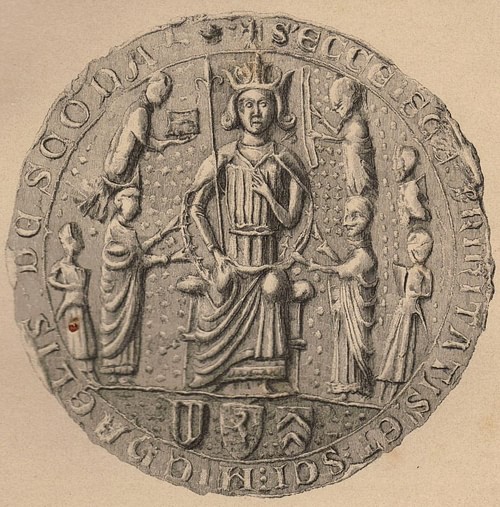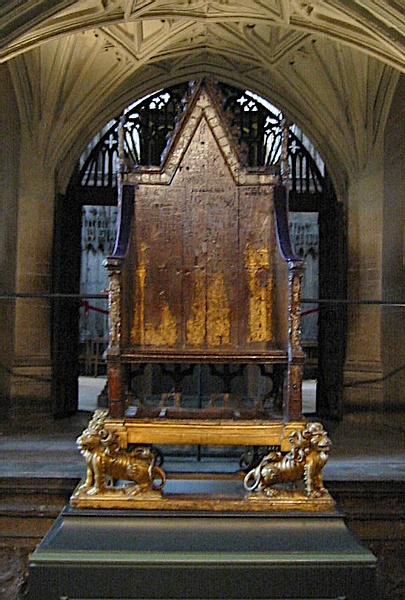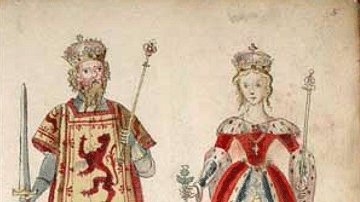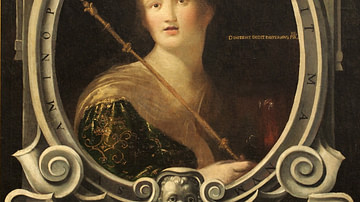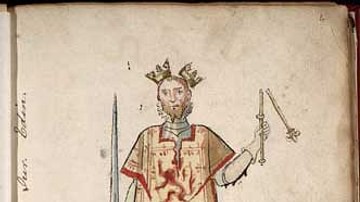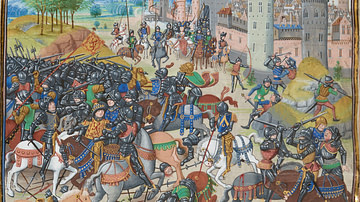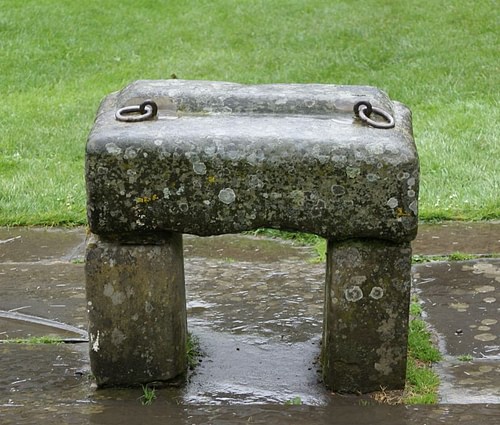
The Stone of Scone (Gaelic: Lia Fail), also known as the Stone of Destiny or Coronation Stone, is a block of sandstone associated with the coronation ceremonies of the medieval monarchs of Scotland. These ceremonies were held at Scone, a prehistoric site in Perthshire, although the precise use of the stone is not known.
In a deliberate act of political propaganda, the Stone of Scone was removed from Scotland by Edward I of England (r. 1272-1307) who made it a part of the English Coronation Chair in Westminster Abbey. The stone was finally returned to Scotland in 1996 and now resides in Edinburgh Castle.
Characteristics
The Stone of Scone is a rectangular slab of yellow sandstone which most likely is Scottish in origin, perhaps from the Lower Old Red Sandstone rocks in the region of Perthshire. It measures approximately 66 cm x 28 cm (26 x 11 in) and weighs around 152 kg (336 pounds). The stone is plain with the exception of a single carved Latin cross. Today it resides in the Crown Room of Edinburgh Castle alongside other items of the Scottish regalia.
Myths & Legends
For a rather nondescript slab of sandstone, the Stone of Destiny comes with a remarkable baggage of myth and folklore. According to the legend, the stone was the very one which Jacob - the ancestor of the people of Israel - used as a pillow when he was in Bethel (a city north of Jerusalem) and experienced a vision of angels ascending and descending a celestial ladder to heaven.
The stone then enjoyed an extraordinary Mediterranean tour which saw it move from the Middle East to Egypt, Sicily, and Spain. Finally, the stone arrived in Ireland around 700 BCE where it was set up at the Hill of Tara, the Neolithic site in County Meath where tradition has it the ancient kings of Ireland were acclaimed. In some sources, it was then the legendary Irish ruler Fergus Mor who brought the stone to Scotland around 500. In another version of the legend, the stone was brought from Ireland to Scotland by Princess Scota, the daughter of an Egyptian pharaoh. There is also some confusion as to whether the present Stone of Destiny is the same stone as the one related to these legends because some early medieval chroniclers describe it as a carved stone throne. Alternatively, the present stone may once have been a part of this more elaborate throne.
The stone's new home in Scotland was either Dunstaffnage Castle on the western coast or, more likely given its history, the nearby island of Iona, part of the Inner Hebrides group. Iona was an ancient holy site for the Christian ascetics known as the Culdees, and it became the traditional burial ground for Scottish monarchs. Indeed, the site has a very long history with its prehistoric barrows and monuments. The stone remained at Iona for the next 350 years, and a legend grew that only where the Stone of Destiny was located would Scottish kings rule. The author Sir Walter Scott (1771-1832 CE) claimed that a piece of metal was once attached to the stone which carried the following engraved verse:
Unless the fates be faulty grown
And prophet's voice be vain
Where'er is found this sacred stone
The Scottish race shall reign.
Relocation by Kenneth MacAlpin
The Celtic king Kenneth MacAlpin (also spelt Cinaed mac Ailpin or mac Ailpein, r. c. 842-858) ruled the Kingdom of the Scots or Alba as it is sometimes known. Kenneth is credited with taking the Stone of Destiny to Scone in Perthshire around 843, perhaps as a symbol of his subjugation of the Picts who may have used the stone for their own coronation ceremonies. It was used in the ceremonies held at Scone to inaugurate Scottish kings thereafter. Lords and bishops gathered at Scone, and later at Scone Abbey, to witness their king being acclaimed and to swear oaths of loyalty. The king's long genealogy was also proclaimed to the gathered dignitaries. Scottish kings were, as yet, not crowned or anointed with holy oil - this form of coronation ceremony would only take place from the 14th century onwards. The king did not perhaps sit on the stone either but, rather, it was used as an altar during the ceremony and set upon the small artificial mound known as Moot Hill or the 'Hill of Belief'. Alternatively, the stone may have been used in different ways over the centuries as, in a detailed description of the ceremony of Alexander III of Scotland (r. 1249-1286), it is stated by John of Fordun that Alexander did sit on the stone.
If the king was married, then the queen received her inauguration service after her husband. By the 12th century, Scottish kings were given familiar symbols of power such as a sword, sceptre, rod, and orb. In addition, the ancient sacred site of Scone was given its own monastery c. 1115 by Alexander I of Scotland (r. 1107-1124). The monastery, first a priory and then, later, a full abbey, was founded by Augustinian canons from Nostel Abbey in Yorkshire.
Removal By Edward I
The Stone of Scone's destiny was about to be changed by an Englishman, one of Scotland's greatest ever enemies. Edward I of England adjudicated over who became the successor of Alexander III of Scotland, an event often termed as the Great Cause. Top candidates were the powerful nobleman John Balliol and Robert Bruce (b. 1210 and grandfather of his more famous namesake). In 1292, Edward plumbed for Balliol, perhaps because he was the weaker of the two and so could be more easily manipulated. John was to be the last medieval Scottish king to be crowned on or near the Stone of Scone on 30 November 1292. As it turned out, the Scots themselves grew tired of Balliol's ineffective responses to Edward's domination, and open rebellion was in the air. In 1295 Scotland formally allied itself with France - the first move in what became known as the 'Auld Alliance' - a step too far for the English king.
Edward I then invaded Scotland, personally leading an army of 25,000-30,000 men. The king thus earned his nickname as 'the Hammer of the Scots', and he was intent on total conquest. Balliol surrendered after the Battle of Dunbar in 1296, and three English barons were nominated to rule Scotland. Always with an eye for dramatic gestures regarding enemy cultures, Edward stole the Scottish monarchy's regalia and the Stone of Scone, relocating it to Westminster Abbey in 1297. There it was placed under the seat of the purpose-built English Coronation Chair, often called St. Edward's Chair because Edward I dedicated his prize to the English king and saint, Edward the Confessor (r. 1042-1066). In this act of removal, Edward I was effectively declaring that Scotland was no longer a kingdom but a mere province of England.
There was a legend that the wily Scots had given Edward a substitute stone and kept the real one safe on the Isle of Skye, but the truth of that is unlikely ever to be substantiated, and there is no evidence that Edward did not get his hands on the original. In any case, Scotland was never quite subdued, and more rebellions followed, notably the 1300 uprising led by William Wallace (c. 1270-1305). Edward II of England may have been prepared to return the stone (r. 1307-1327) as part of a peace treaty with Scotland agreed in 1328. However, it seems that the Abbot of Westminster Abbey refused to give it up. Consequently, the Stone of Scone remained in England for the next seven centuries. On 25 March 1306, Robert the Bruce (r. 1306-1329) was the first Scottish king to be crowned without the stone, although the ceremony was held as usual in Scone Abbey.
Later History & Return to Scotland
As fate would have it, a Scottish king did eventually get to be crowned while sitting on the Stone of Scone. This was James VI of Scotland (r. 1567-1625) who also became James I of England CE (r. 1603-1625) when he was crowned in Westminster Abbey in 1603. This happened because his predecessor Elizabeth I of England (r. 1558-1603) had died without children, and James, Elizabeth's closest relative, was invited by the nobles of England to take the throne. James was of the Stuart line, and that house would rule England until 1714, all of its monarchs taking their place above the Stone of Scone in their coronation. The Scots had finally turned the tables on the English after Edward I's theft 300 years earlier, and the legend of the stone had proved correct: a Scottish king now ruled where the stone resided.
From the 19th century, the Stone of Scone became a potent national symbol for the Scots, and there were repeated calls for the stone's return. In 1950 a group of Scottish nationalists managed to break into Westminster Abbey on Christmas Day of all days. They grabbed the stone and took it back to Scotland, but it was recovered by the authorities and returned to Westminster four months later. The stone was finally and this time officially returned to the people of Scotland in 1996, appropriately enough, on 30 November, Saint Andrew's Day, which honours the patron saint of Scotland. There was one catch which illustrates the continuing power of the stone in the imaginations of the peoples on both sides of the border: the stone must be returned to Westminster Abbey on the occasion of a coronation ceremony of a British monarch.
